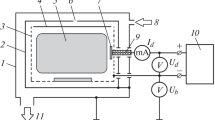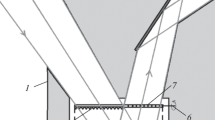Abstract
The results of a study into the limiting operating conditions for gas pressure when using D2, He, Ne, and Ar in the “Active spectroscopy” diagnostic plasma cleaning system for the input mirror of the ITER reactor are presented. The experiments were carried out on a full-sized functional model of a cleaning system based on a discharge with a mesh hollow cathode, with all cathode elements of the discharge cell grounded, including a full-size model of the input mirror. It was found that, when using D2, He, and Ne as working gases, the ignition pressure at a voltage of 750 V is approximately 60, 100, and 20 Pa, respectively, and significantly exceeds the maximum allowable for ITER in the cleaning mode (7 Pa). In this case, the discharge quenching pressure in the considered cases is ≤1 Pa. It is shown that the use of an additional thermionic cathode located inside the discharge cell makes it possible to initialize the discharge at pressures close to the quenching pressure. Turning on the hot cathode with a smooth increase in the heating current in the absence of a discharge current and turning it off after ignition of the discharge provide a significant increase in the life of the hot cathode. The applicability of all gases available for use in ITER and a radical reduction in the operating pressure facilitates the solution of the problem of degassing the vacuum chamber and diagnostic ports of thermonuclear facilities after cleaning the mirrors, which makes it possible to reduce the proportion of heavy impurities in the deuterium–tritium mixture and, accordingly, to increase the plasma temperature during operation impulse.







Similar content being viewed by others
REFERENCES
https://www.iter.org/.
Shigin, P., Materialy 18-oi Vserossiiskoi konferentsii “Diagnostika vysokotemperaturnoi plasmy” (Proc. 18th All-Russian Conference “Diagnostics of High-Temperature Plasma”), Moscow, 2019, IDM UID: Y5QRZ2.
Shigin, P., Babinov, N., De Temmerman, G., Danisi, A., Dmitriev, A., Larsen, J., Madsen, R., Marot, L., Moser, L., Mukhin, E., Kochergin, M., Ortiz, R., Razdobarin, A., Reichle, R., Pitts, R., Samsonov, D., Tsalas, M., Udintsev, V., Vayakis, G., and Walsh, M., Fusion Eng. Des., 2021, vol. 164, p. 112162. https://doi.org/10.1016/j.fusengdes.2020.112162
Rogov, A.V. and Kapustin, Yu.V., Instrum. Exp. Tech., 2021, vol. 64, no. 3, pp. 393–400. https://doi.org/10.1134/S0020441221030313
Shoshin, A., Burdakov, A., Ivantsivskiy, M., Polosatkin, S., Klimenko, M., Semenov, A., Taskaev, S., Kasatov, D., Shchudlo, I., Makarov, A., and Davydov, N., IEEE Trans. Plasma Sci., 2000, vol. 48, no. 6, p. 1474. https://doi.org/10.1109/TPS.2019.2937605
Lisovskii, V.A. and Yakovin, S.D., Tech. Phys., 2000, vol. 45, no. 6, p. 727.
Funding
This work was supported by the National Research Center “Kurchatov Institute” (Order no. 3026 dated November 25, 2021).
Author information
Authors and Affiliations
Corresponding author
Ethics declarations
The authors declare they have no conflicts of interest.
Rights and permissions
About this article
Cite this article
Rogov, A.V., Kapustin, Y.V. Initializing the Discharge in the “Active Spectroscopy” Diagnostic Mirror Cleaning System of the ITER Reactor Using a Thermoemission Cathode. Instrum Exp Tech 65, 426–432 (2022). https://doi.org/10.1134/S0020441222030162
Received:
Revised:
Accepted:
Published:
Issue Date:
DOI: https://doi.org/10.1134/S0020441222030162




